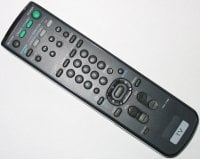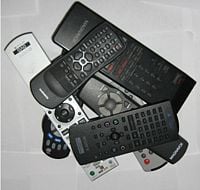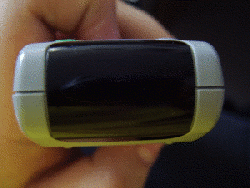Difference between revisions of "Remote control" - New World Encyclopedia
(article imported, fixed, credited) |
(article ready) |
||
| Line 1: | Line 1: | ||
| − | {{ | + | {{images OK}} |
| + | {{ready}} | ||
| + | |||
[[Image:Television remote control.jpg|frame|right|A television remote control]] | [[Image:Television remote control.jpg|frame|right|A television remote control]] | ||
[[Image:Piledvariousremotes.JPG|thumb|200px|right|A pile of various remote controllers]] | [[Image:Piledvariousremotes.JPG|thumb|200px|right|A pile of various remote controllers]] | ||
| Line 48: | Line 50: | ||
Sometimes remotely controlled machinery is necessary in emergency situation such as radioactive or toxic environment to avoid human casualties to prevent damage to human health. For example, remotely controlled robots were used during liquidation of circumstances of [[Chernobyl disaster]]. | Sometimes remotely controlled machinery is necessary in emergency situation such as radioactive or toxic environment to avoid human casualties to prevent damage to human health. For example, remotely controlled robots were used during liquidation of circumstances of [[Chernobyl disaster]]. | ||
===Military=== | ===Military=== | ||
| − | In [[World War I]] the [[Imperial German Navy]] employed what were called ''Electric Motor Boats'' (or EMBs) against coastal shipping. These were driven by [[internal combustion]] engines, and controlled remotely from a shore station through several miles of wire wound on a spool on the boat. An aircraft was used to signal directions to the shore station. EMBs carried a high explosive charge in the bow and traveled at speeds of thirty knots.<ref>Lightoller, | + | In [[World War I]] the [[Imperial German Navy]] employed what were called ''Electric Motor Boats'' (or EMBs) against coastal shipping. These were driven by [[internal combustion]] engines, and controlled remotely from a shore station through several miles of wire wound on a spool on the boat. An aircraft was used to signal directions to the shore station. EMBs carried a high explosive charge in the bow and traveled at speeds of thirty knots.<ref>Lightoller, C. H. ''Titanic and Other Ships''. London: I. Nicholson and Watson, 1935. {{OCLC|9353219}}</ref> |
The Soviet [[Red Army]] used remotely controlled [[teletank]]s during 1930s in the [[Winter War]] against [[Finland]] and the early stages of the [[Great Patriotic War]]. A teletank is controlled by radio from a control tank at a distance of 500–1,500 meters, the two constituting a ''telemechanical group''. The Red Army fielded at least two teletank battalions at the beginning of the Great Patriotic War. There were also remotely controlled cutters and experimental remotely controlled planes in the Red Army. | The Soviet [[Red Army]] used remotely controlled [[teletank]]s during 1930s in the [[Winter War]] against [[Finland]] and the early stages of the [[Great Patriotic War]]. A teletank is controlled by radio from a control tank at a distance of 500–1,500 meters, the two constituting a ''telemechanical group''. The Red Army fielded at least two teletank battalions at the beginning of the Great Patriotic War. There were also remotely controlled cutters and experimental remotely controlled planes in the Red Army. | ||
===Space=== | ===Space=== | ||
| − | Remote control technology is also used in space travel, for instance the Russian [[Lunokhod | + | Remote control technology is also used in space travel, for instance the Russian [[Lunokhod program|Lunokhod]] vehicles were remote-controlled from the ground. Direct remote control of space vehicles at greater distances from the earth is not practical due to increasing signal delay times. |
===Video games=== | ===Video games=== | ||
| − | [[Video game consoles]] had not used wireless controllers until recently, mainly because of the difficulty involved in playing the game while keeping the infrared transmitter pointed at the console. Early wireless | + | [[Video game consoles]] had not used wireless controllers until recently, mainly because of the difficulty involved in playing the game while keeping the infrared transmitter pointed at the console. Early wireless controllers were cumbersome and when powered on alkaline batteries, lasted only a few hours before they needed replacement. Some wireless controllers were produced by third parties, in most cases using a radio link instead of infrared. Even these were very inconsistent, and in some cases, had transmission delays, making them virtually useless. The first official wireless controller made by a first party manufacturer was the [[WaveBird]] for [[Nintendo Gamecube]]. The Wavebird changed the face of wireless technology in video game consoles. In the [[History of video game consoles (seventh generation)|current generation]] of gaming consoles, wireless controllers have become the standard. |
===Toys=== | ===Toys=== | ||
| Line 81: | Line 83: | ||
* [[TV-B-Gone]] | * [[TV-B-Gone]] | ||
* [[JP1 remote]], a common interface that allows ad-hoc reprogramming of some remote controls | * [[JP1 remote]], a common interface that allows ad-hoc reprogramming of some remote controls | ||
| + | |||
| + | ==Notes== | ||
| + | <references/> | ||
== External links == | == External links == | ||
| + | All links Retrieved November 28, 2007. | ||
| + | |||
* [http://users.pandora.be/davshomepage Description of infrared remote protocols] | * [http://users.pandora.be/davshomepage Description of infrared remote protocols] | ||
* [http://www.howell1964.freeserve.co.uk/remotes/index_handsets.htm Infra-red handset technical overview] | * [http://www.howell1964.freeserve.co.uk/remotes/index_handsets.htm Infra-red handset technical overview] | ||
| − | * [http://www.howell1964.freeserve.co.uk/remotes/irrc_systems.htm Infra-red handset | + | * [http://www.howell1964.freeserve.co.uk/remotes/irrc_systems.htm Infra-red handset signaling systems] |
* [http://www.sbprojects.com/knowledge/ir/ir.htm Infra-red Remote Control Theory] | * [http://www.sbprojects.com/knowledge/ir/ir.htm Infra-red Remote Control Theory] | ||
* [http://www.zenith.com/sub_about/about_remote.html Five Decades of Channel Surfing: History of the TV Remote Control] | * [http://www.zenith.com/sub_about/about_remote.html Five Decades of Channel Surfing: History of the TV Remote Control] | ||
* [http://www.electronicadventure.us/history.htm New Remote's History of the Remote Control] | * [http://www.electronicadventure.us/history.htm New Remote's History of the Remote Control] | ||
| − | |||
| − | |||
| − | [[Category: | + | [[Category:Physical sciences]] |
| − | [[Category: | + | [[Category:Electronics]] |
{{credits|174152563}} | {{credits|174152563}} | ||
Revision as of 19:54, 28 November 2007
A remote control is an electronic device used for the remote operation of a machine.
The term remote control can be also referred to as "remote" or "controller" when abbreviated. It is known by many other names as well, such as the "clicker," "changer," "splat," "magic hand," etc. Commonly, remote controls are used to issue commands from a distance to televisions or other consumer electronics such as stereo systems and DVD players. Remote controls for these devices are usually small wireless handheld objects with an array of buttons for adjusting various settings such as television channel, track number, and volume. In fact, for the majority of modern devices with this kind of control, the remote contains all the function controls while the controlled device itself only has a handful of essential primary controls. Most of these remotes communicate to their respective devices via infrared (IR) signals and a few via radio signals. They are usually powered by small AAA or AA size batteries.
History
One of the earliest examples of remote control was developed in 1893 by Nikola Tesla, and described in his patent, U.S. Patent 613809 (PDF), named Method of an Apparatus for Controlling Mechanism of Moving Vehicle or Vehicles.
In 1903, Leonardo Torres Quevedo presented the Telekino at the Paris Academy of Science, accompanied by a brief, and making an experimental demonstration. In the same year, he obtained a patent in France, Spain, Great Britain, and the United States. The Telekino consisted of a robot that executed commands transmitted by electromagnetic waves. It constituted the world's first apparatus for radio control and was a pioneer in the field of remote control. In 1906, in the presence of the king and before a great crowd, Torres successfully demonstrated the invention in the port of Bilbao, guiding a boat from the shore. Later, he would try to apply the Telekino to projectiles and torpedoes, but had to abandon the project for lack of financing.
The first remote-controlled model aeroplane flew in 1932, and the use of remote control technology for military purposes was worked intensively during the Second World War, one result of this being the German Wasserfall missile.
By the late 1930s, several radio manufacturers offered remote controls for some of their higher-end models. Most of these were connected to the set being controlled by wires, but the Philco Mystery Control (1939) was a battery-operated low-frequency radio transmitter [1], thus making it the first wireless remote control for a consumer electronics device.
Television Remote Controls
The first remote intended to control a television was developed by Zenith Radio Corporation in the early 1950s. The remote—unofficially called "Lazy Bones" was connected to the television set by a wire. To improve the cumbersome setup, a wireless remote control called "Flashmatic" was developed in 1955 which worked by shining a beam of light onto a photoelectric cell. Unfortunately, the cells did not distinguish between light from the remote and light from other sources and the Flashmatic also required that the remote control be pointed very accurately at the receiver.[1]
In 1956 Robert Adler developed "Zenith Space Command," a wireless remote. It was mechanical and used ultrasound to change the channel and volume. When the user pushed a button on the remote control it clicked and struck a bar, hence the term "clicker." Each bar emitted a different frequency and circuits in the television detected this noise. The invention of the transistor made possible cheaper electronic remotes that contained a piezoelectric crystal that was fed by an oscillating electric current at a frequency near or above the upper threshold of human hearing, though still audible to dogs. The receiver contained a microphone attached to a circuit that was tuned to the same frequency. Some problems with this method were that the receiver could be triggered accidentally by naturally occurring noises, and some people, especially young women, could hear the piercing ultrasonic signals. There was even a noted incident in which a toy xylophone changed the channels on these types of TVs since some of the overtones from the xylophone matched the remote's ultrasonic frequency.
The impetus for a more complex type of television remote control came in the late 1970s with the development of the Ceefax teletext service by the BBC. Most commercial remote controls at that time had a limited number of functions, sometimes as few as three: next channel, previous channel, and volume/off. This type of control did not meet the needs of teletext sets where pages were identified with three-digit numbers. A remote control to select teletext pages would need buttons for each number from zero to nine, as well as other control functions, such as switching from text to picture, and the normal television controls of volume, station, brightness, colour intensity and so on. Early teletext sets used wired remote controls to select pages but the continuous use of the remote control required for teletext quickly indicated the need for a wireless device. So BBC engineers began talks with one or two television manufacturers which led to early prototypes in around 1977-78 that could control a much larger number of functions. ITT was one of the companies and later gave its name to the ITT protocol of infrared communication. [2]
Other Remote Controls
In the 1980’s Steve Wozniak of Apple, started a company named CL9. The purpose of this company was to create a remote control which could operate multiple electronic devices. The CORE unit as it was named (Controller Of Remote Equipment) was introduced in the fall of 1987. The advantage to this remote controller was that it could “learn” remote signals from other different devices. It also had the ability to perform specific or multiple functions at various times with its built in clock. It was also the first remote control which could be linked to a computer and loaded with updated software code as needed. The CORE unit never made a huge impact of the market. It was much too cumbersome for the average user to program, but it received rave reviews from those who could figure out how to program it. These obstacles eventually lead to the demise of CL9, but one of its employees continued the business under the name Celadon. This was one of the first computer controlled learning remote controls on the market. [3]
By the early 2000s, the number of consumer electronic devices in most homes greatly increased. According to the Consumer Electronics Association, an average American home has four remotes. To operate a home theater as many as five or six remotes may be required, including one for cable or satellite receiver, VCR or digital video recorder, DVD player, TV and audio amplifier. Several of these remotes may need to be used sequentially, but, as there are no accepted interface guidelines, the process is increasingly cumbersome. Many specialists, including Jakob Nielsen [4], a renowned usability specialist and Robert Adler, the inventor of the modern remote, note how confusing, unwieldy and frustrating the multiplying remotes have become.
Technique
Most control remotes for electronic appliances use a near infrared diode to emit a beam of light that reaches the device. This light is invisible to the human eye but carries signals that are detected by the appliance, as well as by the sensor of a digital camera.
With a single channel (single-function, one-button) remote control the presence of a carrier signal can be used to trigger a function. For multi-channel (normal multi-function) remote controls more sophisticated procedures are necessary: one consists of modulating the carrier with signals of different frequency. After the demodulation of the received signal, the appropriate frequency filters are applied to separate the respective signals. Nowadays digital procedures are more commonly used. One can often hear the signals being modulated on the infrared carrier by operating a remote control in very close proximity to an AM radio not tuned to a station.
Usage
Industry
Remote control is used for controlling substations, pump storage power stations and HVDC-plants. For these systems often PLC-systems working in the longwave range are used.
Emergency
Sometimes remotely controlled machinery is necessary in emergency situation such as radioactive or toxic environment to avoid human casualties to prevent damage to human health. For example, remotely controlled robots were used during liquidation of circumstances of Chernobyl disaster.
Military
In World War I the Imperial German Navy employed what were called Electric Motor Boats (or EMBs) against coastal shipping. These were driven by internal combustion engines, and controlled remotely from a shore station through several miles of wire wound on a spool on the boat. An aircraft was used to signal directions to the shore station. EMBs carried a high explosive charge in the bow and traveled at speeds of thirty knots.[2]
The Soviet Red Army used remotely controlled teletanks during 1930s in the Winter War against Finland and the early stages of the Great Patriotic War. A teletank is controlled by radio from a control tank at a distance of 500–1,500 meters, the two constituting a telemechanical group. The Red Army fielded at least two teletank battalions at the beginning of the Great Patriotic War. There were also remotely controlled cutters and experimental remotely controlled planes in the Red Army.
Space
Remote control technology is also used in space travel, for instance the Russian Lunokhod vehicles were remote-controlled from the ground. Direct remote control of space vehicles at greater distances from the earth is not practical due to increasing signal delay times.
Video games
Video game consoles had not used wireless controllers until recently, mainly because of the difficulty involved in playing the game while keeping the infrared transmitter pointed at the console. Early wireless controllers were cumbersome and when powered on alkaline batteries, lasted only a few hours before they needed replacement. Some wireless controllers were produced by third parties, in most cases using a radio link instead of infrared. Even these were very inconsistent, and in some cases, had transmission delays, making them virtually useless. The first official wireless controller made by a first party manufacturer was the WaveBird for Nintendo Gamecube. The Wavebird changed the face of wireless technology in video game consoles. In the current generation of gaming consoles, wireless controllers have become the standard.
Toys
Remote control toys, such as racing cars, boats and even aircraft are a favorite pastime of many children.
See also
- Universal remote
- Channel surfing
- Radio control
- Domotics
- Audience response
- Remote keyless system
- Telecommand
- Remote-controlled animal
- Control Car Remote Control Locomotive
- Garage door opener
Products and standards
- INSTEON
- LIRC
- X10 (industry standard)
- TV-B-Gone
- JP1 remote, a common interface that allows ad-hoc reprogramming of some remote controls
Notes
- ↑ Farhi, Paul. "The Inventor Who Deserves a Sitting Ovation." Washington Post. Feb. 17, 2007.
- ↑ Lightoller, C. H. Titanic and Other Ships. London: I. Nicholson and Watson, 1935. OCLC 9353219
External links
All links Retrieved November 28, 2007.
- Description of infrared remote protocols
- Infra-red handset technical overview
- Infra-red handset signaling systems
- Infra-red Remote Control Theory
- Five Decades of Channel Surfing: History of the TV Remote Control
- New Remote's History of the Remote Control
Credits
New World Encyclopedia writers and editors rewrote and completed the Wikipedia article in accordance with New World Encyclopedia standards. This article abides by terms of the Creative Commons CC-by-sa 3.0 License (CC-by-sa), which may be used and disseminated with proper attribution. Credit is due under the terms of this license that can reference both the New World Encyclopedia contributors and the selfless volunteer contributors of the Wikimedia Foundation. To cite this article click here for a list of acceptable citing formats.The history of earlier contributions by wikipedians is accessible to researchers here:
The history of this article since it was imported to New World Encyclopedia:
Note: Some restrictions may apply to use of individual images which are separately licensed.




